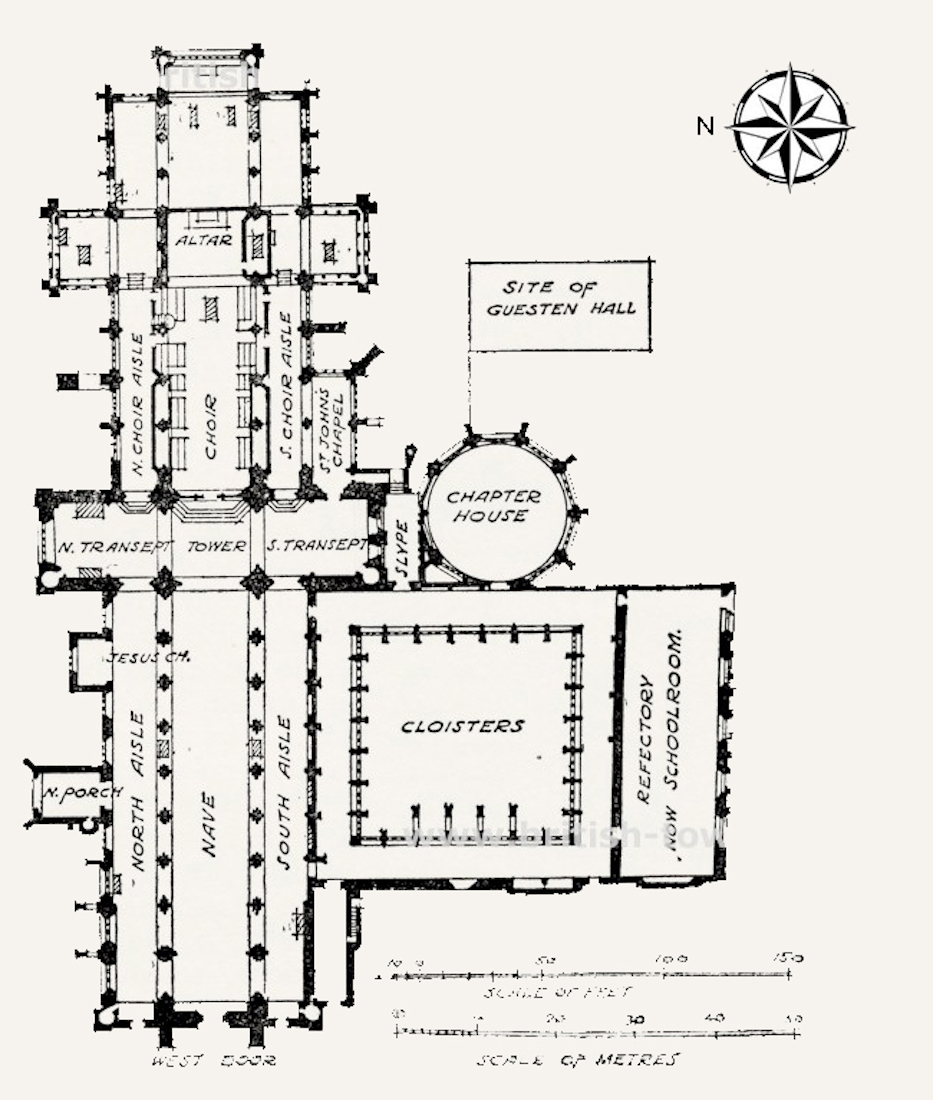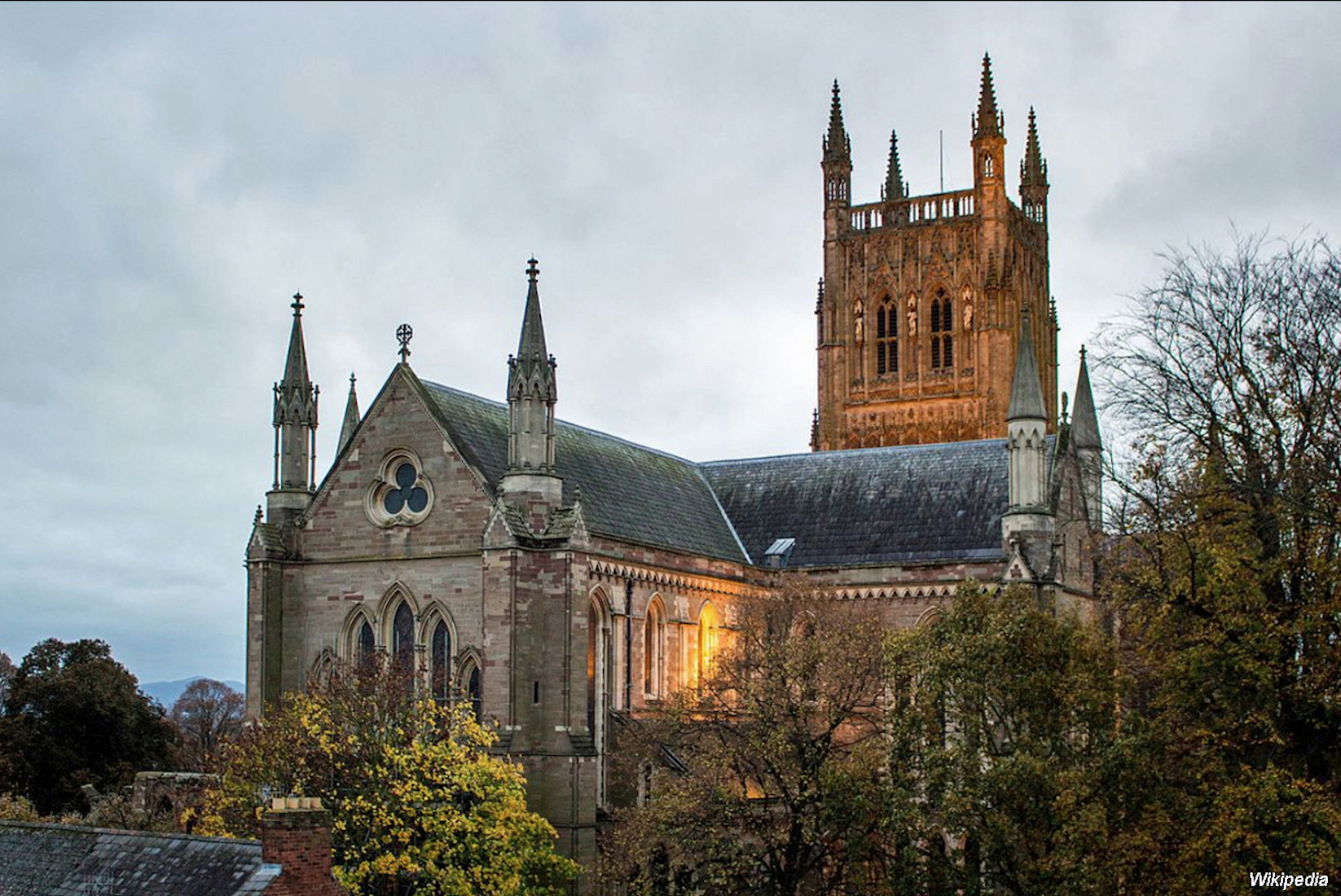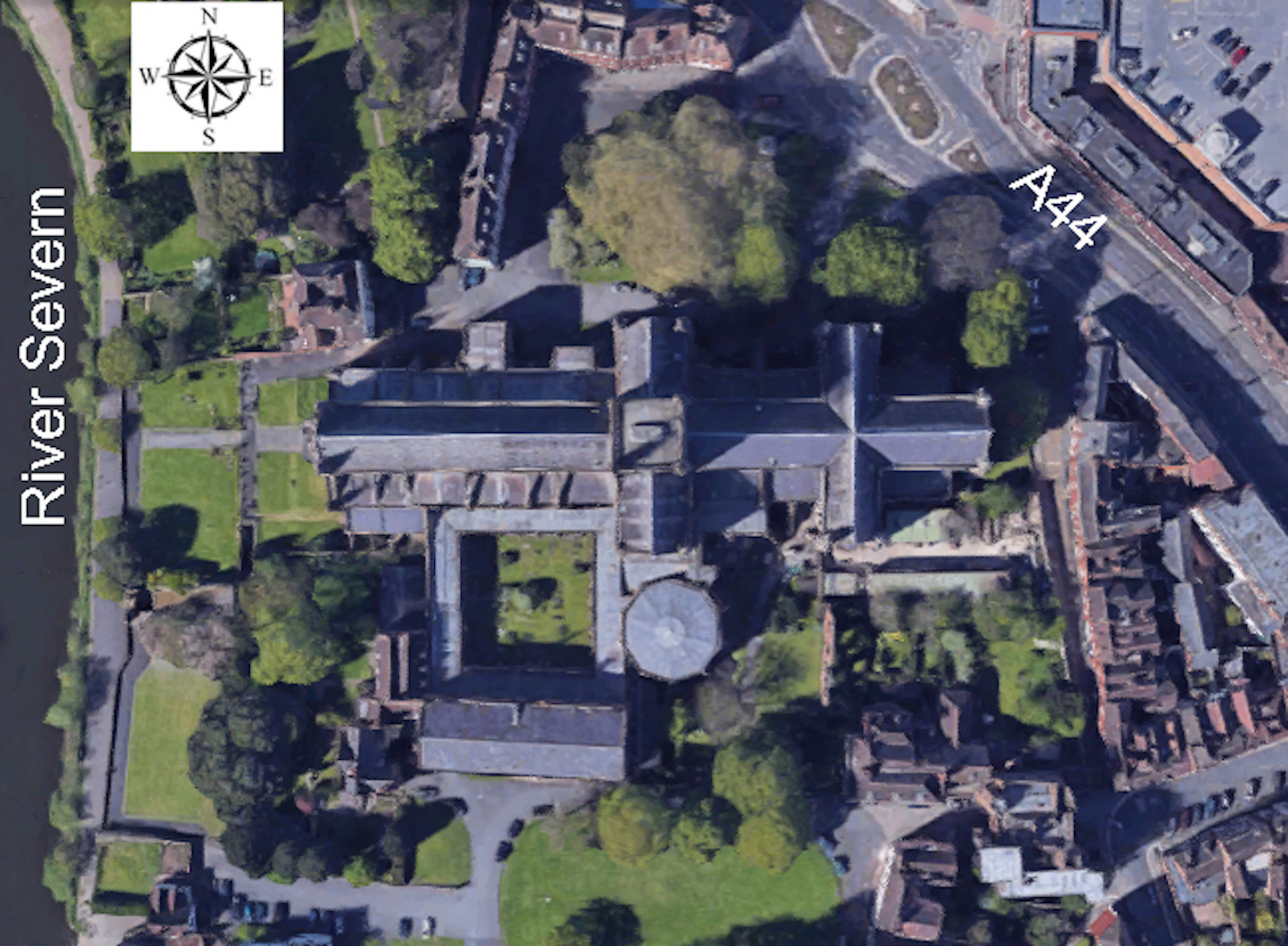WORCESTER CATHEDRAL
WORCESTERSHIRE, ENGLAND
PAUL SCOTT
SATELLITE VIEW
Worcester Cathedral has its axis in a directly east west direction, so our liturgical directions (with Capital letters) coincide exactly with the geographical directions. The Cathedral has the River Severn to its West, and the A44 freeway unwisely placed to its East! The city lies to the North.
The Cathedral has a central tower, two transepts, and to the South a large cloister area with chapter house. There is also a College hall to the South.

This plan gives a better idea of the layout. We begin our exterior walk to the right of the cloisters, and walk around in an anticlockwise direction. At our starting point we re-enter and explore the cloisters and chapter house, before exploring the interior of the Cathedral, starting from the West nave.
This is a Cathedral of fairly simple design. However there is also the crypt with entrance near the South transept.
A brief history of the Cathedral is given below. However, if you want to begin your tour of the Cathedral immediately, tap / click on START . You can also access intermediate points in the tour by a tap / click on the following links:
NOTE ON MAGNIFYING IMAGES
With this website format the images are large enough for most purposes. If there is a need for greater magnification of an image, go to the identical photo on
https://www.flickr.com/photos/paulscottinfo/albums
and use Command - + (Mac) or Windows - + (Windows).
HISTORY
[Wikipedia]
Worcester Cathedral, is an Anglican cathedral in Worcester, situated on a bank overlooking the River Severn. It is the seat of the Bishop of Worcester. Its official name is the Cathedral Church of Christ and the Blessed Mary the Virgin, of Worcester. The present cathedral church was built between 1084 and 1504, and represents every style of English architecture from Norman to Perpendicular Gothic. It is famous for its Norman crypt and unique chapter house, its unusual Transitional Gothic bays, its fine woodwork and its ‘exquisite’ central tower, which is of particularly fine proportions.
The Cathedral’s west facade appeared, with a portrait of Sir Edward Elgar, on the reverse of the £20 note issued by the Bank of England between 1999 and 2007, remaining in circulation as legal tender until 30 June 2010.
Early history
The Cathedral was founded in 680, with a Northumbrian priest, Tatwine, appointed as its first bishop. Tatwine died before he could be consecrated, however, so his successor Bishop Bosel may be regarded as Worcester’s first serving bishop. The first cathedral church, dedicated to Ss. Peter and Paul, was built in this period, but no remains of its architecture survive. The crypt of the present-day Cathedral dates from the 11th century and the time of Wulfstan,Bishop of Worcester.
The community associated with the Cathedral of the early eighth century included members of various clerical orders. The Cathedral community was regulated along formal monastic lines as a consequence of the Benedictine reforms in the second half of the tenth century (one author gives the time range 974-977, another considers 969 more likely). There is an important connection with Fleury Abbey in France, as Oswald, Bishop of Worcester from 961 to 992, was professed at Fleury and introduced the monastic rule of Fleury to the monastery that he established at Worcester around the year 966, which was dedicated – as the present cathedral church is – to St. Mary.
Medieval
The last Anglo-Saxon bishop of Worcester was Wulfstan, who unusually remained bishop after the Norman Conquest until his death in 1095. He was later made a saint.
The Cathedral is the burial place of John, King of England, who succeeded his brother Richard I of England.
The Cathedral Priory was a major landowner and economic force, both in Worcester and the county. Its properties for instance included the priory manor of Bromsgrove. It was a centre of learning and provided schooling. It was associated with hospitals. The Church received a portion of local taxations and ecclesiastical law applied to Christian morals and could result in punishments. It had close political associations with leading gentry and aristocracy. As such, Worcester’s Cathedral had a central role in the medieval life of the city and county. The Cathedral was one of a number of religious institutions in the city.
Relations with the Jewish community of Worcester
The Diocese was notably hostile to the small Jewish community which was established in Worcester. Peter of Blois was commissioned by a Bishop of Worcester, probably John of Coutances, to write a significant anti-Judaic treatise ‘Against the Perfidy of Jews’ around 1190.
William de Blois, as Bishop of Worcester, imposed particularly strict rules on Jews within the diocese in 1219. As elsewhere in England, Jews were officially compelled to wear rectangular white badges. In most places, this requirement was relinquished as long as fines were paid. In addition to enforcing the church laws on wearing badges, Blois tried to impose additional restrictions on usury, and wrote to Pope Gregory in 1229 to ask for better enforcement and further, harsher measures. In response, the Papacy demanded that Christians be prevented from working in Jewish homes, ‘lest temporal profit be preferred to the zeal of Christ’, and enforcement of the wearing of badges.
Dissolution and Reformation
The priory came to an end with King Henry VIII’s Dissolution of the Monasteries. Shortly beforehand, in 1535, the prior William More resigned, and was replaced by Henry Holbeach. More had a reputation for fine living, although his standards seem in line with other senior ecclesiasts of the time. However, there certainly were problems with the administration of the priory, including divisions within the community.
The Protestant Hugh Latimer was bishop from 1535, and preached for reform and iconoclasm. He resigned as bishop in 1539, as a result of a theological turn by Henry VIII towards Roman Catholicism, in the Six Articles. John Bell, a moderate reformer, was bishop from 1539 to 1543, during the period of the priory’s dissolution.
In the early 16th century, Worcester had around 40 monks. This declined slightly in the years immediately before 1540, as recruitment seems to have halted. There were 35 Benedictine monks plus the Prior Holbeach at the time of dissolution, probably 16 January 1540; eleven were immediately given pensions, while the remainder became secular canons in the new Royal College. Holbeach was re-appointed as the first Dean. A further five former monks were pensioned from the college in July 1540.
The former monastic library of Worcester contained a considerable number of manuscripts which are, among other libraries, now scattered over Cambridge, London (British Library), Oxford Bodleian, and the Cathedral library at Worcester of today. Remains of the priory dating from the 12th and 13th centuries can still be seen.
John Bell’s successor as Bishop, Nicholas Heath, was religiously much more conservative and Catholic.
Civil War
During the Civil War, the Cathedral was used to store arms, possibly as early as September 1642. Worcester declared itself for the Crown and was quickly occupied by extra Royalist forces,who were using the building to store munitions when Essex briefly retook the city after a skirmish on its outskirts. The Parliamentary troops then ransacked the Cathedral building. Stained glass was smashed and the organ destroyed, along with library books and monuments.
The See was abolished during the Commonwealth and the Protectorate, approximately 1646–60. The belltower was demolished in 1647 and the building used as a prison in the aftermath of the 1651 battle.
Victorian to present
In the 1860s, the Cathedral was subject to major restoration work planned by Sir George Gilbert Scott and A. E. Perkins. An image of the Cathedral’s west façade appeared on the reverse of the Series E British £20 note commemorating Sir Edward Elgar, issued between 1999 and 2007.
https://en.wikipedia.org/wiki/Worcester_Cathedral




